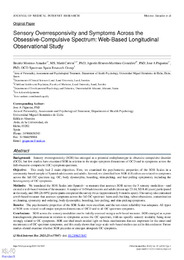Por favor, use este identificador para citar o enlazar este ítem:
https://hdl.handle.net/11000/36136Registro completo de metadatos
| Campo DC | Valor | Lengua/Idioma |
|---|---|---|
| dc.contributor.author | Moreno-Amador, Beatriz | - |
| dc.contributor.author | Cervin, Matti | - |
| dc.contributor.author | MARTINEZ-GONZALEZ, AGUSTIN ERNESTO | - |
| dc.contributor.author | Piqueras, Jose A | - |
| dc.contributor.author | OCD-Spectrum Spain Research Group | - |
| dc.contributor.other | Departamentos de la UMH::Psicología de la Salud | es_ES |
| dc.date.accessioned | 2025-03-26T10:11:12Z | - |
| dc.date.available | 2025-03-26T10:11:12Z | - |
| dc.date.created | 2023-04-13 | - |
| dc.identifier.citation | Journal of Medical Internet Research, Vol 25 (2023) | es_ES |
| dc.identifier.issn | 1438-8871 | - |
| dc.identifier.uri | https://hdl.handle.net/11000/36136 | - |
| dc.description.abstract | Background: Sensory overresponsivity (SOR) has emerged as a potential endophenotype in obsessive-compulsive disorder (OCD), but few studies have examined SOR in relation to the major symptom dimensions of OCD and to symptoms across the full obsessive-compulsive (OC) symptom spectrum. Objective: This study had 2 main objectives. First, we examined the psychometric properties of the SOR Scales in a community-based sample of Spanish adolescents and adults. Second, we identified how SOR difficulties are related to symptoms across the full OC spectrum (eg, OC, body dysmorphic, hoarding, skin-picking, and hair-pulling symptoms), including the heterogeneity of OC symptoms. Methods: We translated the SOR Scales into Spanish—a measure that assesses SOR across the 5 sensory modalities—and created a web-based version of the measure. A sample of 1454 adolescents and adults (mean age 23.84, SD 8.46 years) participated in the study, and 388 (26.69%) participants completed the survey twice (approximately 8 months apart). The survey also contained a web-based measure that assesses symptoms across the full OC spectrum: harm and checking, taboo obsessions, contamination or cleaning, symmetry and ordering, body dysmorphic, hoarding, hair-pulling, and skin-picking symptoms. Results: The psychometric properties of the SOR Scales were excellent, and the test-retest reliability was adequate. All types of SOR were related to all major symptom dimensions of OCD and to all OC spectrum symptoms. Conclusions: SOR across the sensory modalities can be validly assessed using a web-based measure. SOR emerged as a pure transdiagnostic phenomenon in relation to symptoms across the OC spectrum, with no specific sensory modality being more strongly related to OC symptoms. SOR can shed much needed light on basic mechanisms that are important for the onset and maintenance of OC spectrum symptoms, and this study shows that large-scale web-based studies can aid in this endeavor. Future studies should examine whether SOR precedes or emerges alongside OC symptoms. | es_ES |
| dc.format | application/pdf | es_ES |
| dc.format.extent | 12 | es_ES |
| dc.language.iso | eng | es_ES |
| dc.publisher | JMIR Publications | es_ES |
| dc.rights | info:eu-repo/semantics/openAccess | es_ES |
| dc.rights | Attribution-NonCommercial-NoDerivatives 4.0 Internacional | * |
| dc.rights.uri | http://creativecommons.org/licenses/by-nc-nd/4.0/ | * |
| dc.subject | sensory symptoms | es_ES |
| dc.subject | sensory overresponsivity | es_ES |
| dc.subject | obsessive-compulsive | es_ES |
| dc.subject | hair-pulling | es_ES |
| dc.subject | skin-picking | es_ES |
| dc.subject | hoarding | es_ES |
| dc.subject | body dysmorphic | es_ES |
| dc.subject | adolescents | es_ES |
| dc.subject | adults | es_ES |
| dc.subject.other | CDU::1 - Filosofía y psicología::159.9 - Psicología | es_ES |
| dc.title | Sensory overresponsivity and symptoms across the obsessive-compulsive spectrum: web-based longitudinal observational study | es_ES |
| dc.type | info:eu-repo/semantics/article | es_ES |
| dc.relation.publisherversion | https://doi.org/10.2196/37847 | es_ES |

Ver/Abrir:
2023_JMIR SENSORY.pdf
257,55 kB
Adobe PDF
Compartir:
 La licencia se describe como: Atribución-NonComercial-NoDerivada 4.0 Internacional.
La licencia se describe como: Atribución-NonComercial-NoDerivada 4.0 Internacional.
.png)